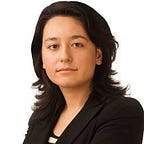Art Docents of Los Gatos Launch “Big Data” Art Workshop For Sixth Graders
These multi-colored spirals lined up on a giant sheet of white paper might look as mysterious as Egyptian hieroglyphics to the uninitiated, but they’re actually representations of how a class of sixth graders spend their time at Los Gatos’ Raymond J. Fisher Middle School.
The spirals form a “data portrait” inspired by the Austin, Texas-based Laurie Frick, an artist who “explores the bumpy future of data captured about us.”
Each spiral pictured here represents the hours spent in a typical sixth grader’s day: The colored dots at the center of a spiral represent a child’s favorite category of activity, with the other categories (sleep, meals, school, homework, screen-time, physical activity, creative and “other,” spiraling outwards to the least favored.
The kids created these data portraits during a workshop and lesson about the concept of “big data.” It’s a new 90-minute class taught during a math period by the Art Docents of Los Gatos, and is part of a push by the Los Gatos Education Foundation and the school district to incorporate more of a STEAM approach to learning.
STEAM stands for an educational approach that guides student inquiry, dialogue, and critical thinking, and it incorporates elements of science, technology, engineering, the arts and mathematics into lessons.
The idea behind the innovative and unusual new lesson is to engage students in a simple, accessible way in order to introduce them to the more complex idea of “big data,” and how this modern phenomenon can reveal important insights in the world around us.
The parent volunteer-run workshop does this by engaging he kids in a relatively simple and fun hands-on charting and art activity. The insights revealed about their days tend to surprise and excite the sixth graders as the spirals show them an aspect of their lives they hadn’t explicitly thought about before. (They also live learning about how their peers spend their time, and how much screen time their buddies are allowed to have everyday, for example.)
The Art Docents’ Big Data Workshop showcases the work of several notable big data artists to illustrate how modern computing and art can quantify and reveal what’s otherwise invisible around us.
The group’s goal is to tie as much of the idea of big data and big data art to aspects of the kids’ lives. So, for example, the kids learn about the eCloud dynamic sculpture of weather data above the walkway between gates 22 and 23 at the San Jose International Airport. Through discussion and the introduction of key terms, the workshop also introduces the idea of data science as a career.
“I think if you expose kids to the vocabulary, it opens their world to new possibilities,” explains Julie Ferrario, the Art Docents of Los Gatos’ president.
In addition to videos of Frick’s art works of self-quantification, the lesson shows how 25-year-old climate scientist and artist Jill Pelto highlighted the declining population of Coho Salmon through an illustrated chart of the population data; how artist Stanford Kay used data visualization in the shape of a foot to illustrate the relative “carbon footprints” of countries around the world; how artist Aaron Koblin visualized and found interesting patterns in flights across the U.S. and New Year’s Eve text message flows across wireless phone networks.
The lesson explains what Big Data is, how activities in our everyday lives generate it through our use of social media, and navigational devices for example. The kids learn, for example, that the millions of Instagram photos, Twitter messages and uploaded documents online add up to “quintillions” of bytes exchanged online every day, and how that data can be analyzed and interpreted to detect trends. The kids learn that hometown company Netflix analyzes viewing patterns to create shows, and that other entities are using and manipulating big sets of data to build self-driving cars, and to find cures for diseases, among other things. Kids also learn what kinds of professional roles data scientists can take.
“Art is as much of a product of the technologies available to artists as it is of the sociopolitical time it was made in, and the current world is no exception,” noted writer Jacoba Urista in a 2015 article in The Atlantic.
The class was inspired by Rick Smolan and Jennifer Erwitt’s coffee table book “The Human Face of Big Data,” which was sponsored by Silicon Valley companies CISCO, EMC, Originate, tableau, and VMWare (and Fedex.) Ferrario’s husband Dale, works at VMWare and suggested that Julie consider teaching about Big Data Art as part of the Art Docents’ repertoire of art appreciation classes in the Los Gatos Union School District.
“Given where we live, I think the expectation from parents is that the kids are going to get the latest innovations as part of their STEM experience at school, so I was trying to somehow get technology more deeply into what [the Art Docents] do all the time,” he said.
The Art Docents of Los Gatos’ curriculum team worked with district staff and iterated several versions of the workshop over the past year and a half to incorporate the innovations of Silicon Valley into a fun and educational part of middle school math class.
The non-profit, founded in 1973, is a volunteer-run arts and cultural educational organization. It serves more than 3,000 students in the Los Gatos Union School District, which includes Daves Avenue, Blossom Hill, Van Meter, and Lexington elementary schools and Fisher Middle School.
